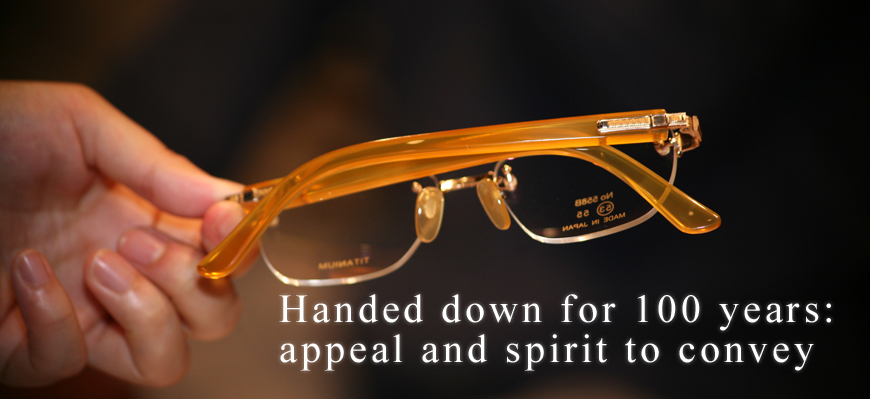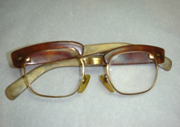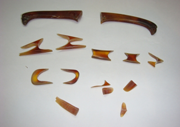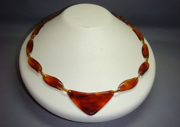
Atsunori Tanaka
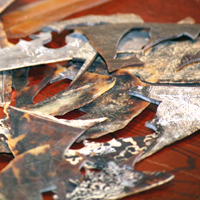
Tortoiseshell turtle's (a type of sea turtle) shells used for his work
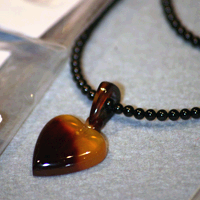
A heart-shaped pendant. Any shape can be made if design is prepared.
What is tortoiseshell work?
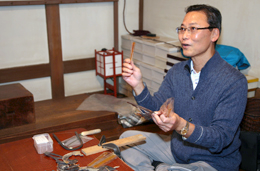
What is the charm of tortoiseshell work?
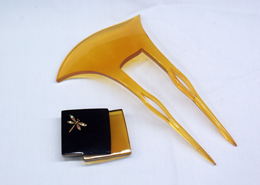
Although tortoiseshell work has a strong image as being suitable for elderly people, I'd like younger people to wear tortoiseshell work. Glasses made from tortoiseshell are different from metal frame glasses and comfortable to wear. Once you buy a pair of tortoiseshell glasses and use it, you must want to buy another one. Earpicks made from tortoiseshell also come to fit your ears after using it for a while. Tortoiseshell seems to have warmth because it is a natural material. Patterns are also unique. Since tortoiseshell work can be used for a long time if you take care of it, some customers use tortoiseshell work of which design is not affected by trends, including pin and ornamental clasp for holding an obi, by themselves, and present other tortoiseshell work to their grandchildren.
The reason Tanaka was determined to be an Edo-style Tortoiseshell Worker.
Could you tell me why you became an Edo-style Tortoiseshell Worker?
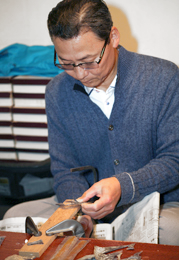
Tortoiseshell
From what materials are pieces of tortoiseshell work made?
Shells of tortoiseshell turtles, a kind of sea turtle, are only used for tortoiseshell work. A tortoiseshell turtle has sets of 13 shells in various shapes at its belly, sides and rear. Jagged shells at the rear are the most expensive parts and called "Tsume," from which light brown tortoiseshell can be made. Generally, most shells are blackish. 80 to 90 tortoiseshell turtles out of 100 have blackish shells. About 10% of tortoiseshell turtles have whitish shells. Colors and patterns of shells are different depending on each individual. Shells of a small tortoiseshell turtle that is about five years old might be used for thin products, but generally, shells of turtles that are below 10 years old cannot be used as tortoiseshell.
Is it possible to make tortoiseshell work from shells of turtles other than tortoiseshell turtles?
I think shells of tortoiseshell turtles can only be used for tortoiseshell work. It seems that shells of turtles other than tortoiseshell turtles cannot be stuck together. There are pieces of work which are made from shells of a green turtle and a tortoiseshell turtle, but in the present, such a combination is not used because they do not properly stick together. The import of tortoiseshell turtle shells was banned in the prewar period, so tortoiseshell workers used hooves of horses and cows to make pieces of work. Tortoiseshell had been prohibited goods since the Edo Period, so there are few antique tortoiseshell products left in Japan. Since colors of products made from hooves are similar to those of tortoiseshell, ordinary people cannot tell real tortoiseshell. Only people of high standing, such as feudal lords, could have tortoiseshell products. Also, tortoiseshell is eaten by worms and deteriorates, so few old tortoiseshell products remain.
Do old techniques and products differ from the present ones?
I heard that, since there was no machine in the past, tortoiseshell workers took time to polish tortoiseshell products using buckskin. They also stuck pieces of tortoiseshell together with albumen. They used a tool like a brazier as substitute for an iron to stick the pieces together while adjusting the heat. Nowadays, Western-style accessories, such as a brooch, pendant top and necklace, are more popular. These bookmarks and paper knives are products I made on an impulse. I will make any products if there are orders. I have been asked to make a comb for grooming a beard, a censer, a Buddhist rosary and so on.
The import of tortoiseshell turtles was banned in the Washington Convention in 1993. How do you cope with it? What will be the future of tortoiseshell products?
15 years have passed since the ban was implemented. All tortoiseshell workers have used stocks to find a way. Cultivation of tortoiseshell turtles is now being advanced on Ishigaki Island, Okinawa Prefecture, and its commercialization is undertaken. Although I am not certain, the turtles cultivated on the island will also be used by tortoiseshell workers in a few years. Shells of cultivated and wild turtles look pretty much the same.
Creation techniques
Could you tell me about the creation process?
First of all, I draw a pattern, and carve it out. Next, I use a file for scabbling shells. The file is called "Gangiri" and only used by tortoiseshell workers. To begin with, I remove scratches on the surface with Gangiri. Then, I remove scratches made by Gangiri with a penknife, and polish the shells with horsetail leaves after sandpapering them. After that, I press them using heat and water.
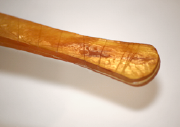
What is the most difficult process?
Sticking sheets of tortoiseshell together is the most difficult process. It is necessary to make sheets of tortoiseshell flat and stick them together. It is said that tortoiseshell products made by skilled tortoiseshell workers do not peel off. Shells of turtles grow over years, and have layers like growth rings of a tree. Therefore, the materials themselves might break naturally. There is also a possibility that the materials are affected by climate and other conditions and break naturally.
Tanaka's works
How do you create those colorful tortoiseshell glasses?
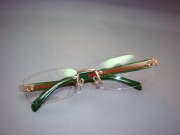
What kind of subject matter do you often use for accessories?
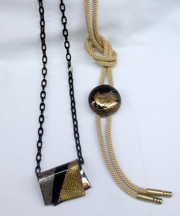
(Left: Gold lacquered tortoiseshell product that serves both as a pendant and an ornamental clasp / Right: Bolo tie with a clasp decorated with the makie technique)
Are there craftsmen who repair old tortoiseshell products?
There are not so many craftsmen who can repair tortoiseshell products. However, customers who want to wear old-fashioned products that are their mementos find out craftsmen like us, and ask them to repair the products. Tortoiseshell products cannot be repaired and polished at any department store, so those customers need to find out a specialist shop. If a customer ask me to repair a pair of tortoiseshell glasses that the customer has as a memento, or if a customer ask me to process a tortoiseshell product into something because the product is a memento, I would turn it into an earring or necklace, or polish it and replace lenses with new ones.
How should tortoiseshell products be handled and stored?
Tortoiseshell consists of proteins, so it is eaten by worms if it is not used and stored for about one year. You can store tortoiseshell products with mothballs in a box made of paulownia wood, and then expose the products to the air every six months. It is better to store the products after wiping out oil from them as much as possible. As for products, such as a pair of glasses, which are used every day, the products last long if you clean them up with a soft cloth before going to bed.
Tortoiseshell products are susceptible to steam, so you should not take a bath with glasses on, or should not expose them to water. If you wipe a pair of glasses dry immediately, no problem arises. However, if you leave it as it is, it cracks and deteriorates. After you polish tortoiseshell products, they look brand-new again. As for a pair of glasses, it last long if you have it professionally polished once in a year or two.
Tanaka's activities
You have appeared in video sites on the Internet, and held a hands-on class. What kind of activity are you doing?
Nowadays, it is difficult to obtain tortoiseshell shells, and there are few successors. I think young people have few opportunities to come in contact with real tortoiseshell products. I want young people to know tortoiseshell products and craftsmen's techniques, so I try to give interviews as many as possible. Many customers who buy tortoiseshell glasses are over the age of 60 because the glasses are expensive. However, I have made many glasses that I want people in their 40s and 50s to wear. Since materials are expensive and tortoiseshell products are craftworks purely made by hand, the products are also expensive. However, I want many customers to try the products.
I have held a hands-on class since about two years ago. Students from all over the country have visited my work space on their school trips or as extracurricular classes. They have made simple products, such as a charm, which can be completed in about two hours, by cutting prepared materials with a fretsaw and polishing them.

Atsunori Tanaka

Tortoiseshell turtle's (a type of sea turtle) shells used for his work

A heart-shaped pendant. Any shape can be made if design is prepared.
What is tortoiseshell work?

Tortoiseshell work originated in Portugal, and was introduced into Nagasaki from the Hong Kong area after going through China. Most tortoiseshell work in Japan spread from Nagasaki. Although Edo-style Tortoiseshell Work is recognize by the Tokyo Metropolitan Government as traditional craftwork, it does not differ from Nagasaki-style Tortoiseshell Work. The both tortoiseshell works use the same materials, their work processes are pretty much the same. In the past, there were some tortoiseshell workers in Osaka, but in the present, there are a very few workers. Shells of tortoiseshell turtles, a kind of sea turtle, are used for tortoiseshell work. Chinese characters for tortoiseshell are "Bekko" that consist of Chinese characters "Suppon," or Chinese softshell turtle, and "Ko," or shell. In the Edo Period, the use of tortoiseshell was prohibited, so tortoiseshell was disguised as Chinese softshell turtles' shells.
What is the charm of tortoiseshell work?

Although tortoiseshell work has a strong image as being suitable for elderly people, I'd like younger people to wear tortoiseshell work. Glasses made from tortoiseshell are different from metal frame glasses and comfortable to wear. Once you buy a pair of tortoiseshell glasses and use it, you must want to buy another one. Earpicks made from tortoiseshell also come to fit your ears after using it for a while. Tortoiseshell seems to have warmth because it is a natural material. Patterns are also unique. Since tortoiseshell work can be used for a long time if you take care of it, some customers use tortoiseshell work of which design is not affected by trends, including pin and ornamental clasp for holding an obi, by themselves, and present other tortoiseshell work to their grandchildren.






